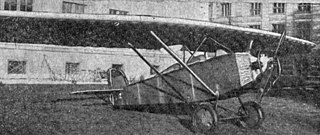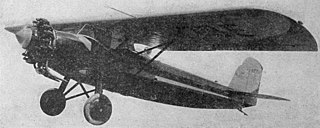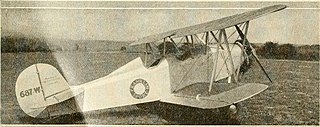The Shackleton-Murray SM.1 was a single-engined two-seat light aircraft designed in Britain and flying in 1933. It was a pusher driven parasol winged monoplane. Only one was built.
The Escapade Kid is a single-engine, single-seat, high-wing monoplane, developed and built in the United Kingdom in the 2000s.
The Caudron C.251 Et-2 was a French tandem seat, open cockpit biplane designed as an intermediate trainer and built in 1931. It did not go into production.
The Caudron C.220 was a two-seat French biplane trainer. Only two were built, using different engines.
The Dupuy D-40 was a French built, low powered monoplane designed for touring abroad. The only example was used for an uncompleted journey to Saigon.
The Potez 51 was a 1930s French intermediate trainer, intended to replace the ageing Potez 25 which had sold worldwide. It did not go into production.
The Leduc RL-12 was a French low power, economical, parasol wing, single seat aircraft. First flown in July 1939, its development was halted by World War II.

The Mauboussin M.112, M-12 or Mauboussin M.XII was originally called the Peyret-Mauboussin PM XII and was renamed when Mauboussin founded his own company in 1931, ending his partnership with Louis Peyret. It was a French, single-engine, two-seat, low cantilever wing touring monoplane. At least six were built.

The Rogalski and Wigura R.W.1 was designed and built by a pair of students at Warsaw Technical University in 1927. The single example was a two-seat parasol-wing monoplane which entered two national competitions, served the Warsaw Academic Aeroclub and also towed an advertising banner.
The Yackey Monoplane was an American three seat parasol monoplane flown in the late 1920s. Two prototypes had some success in the 1927 New York - Spokane National Air Derby and orders were placed but a crash killed its designer and ended production.
The Stiles Dragon Fly was an American two seat monoplane aircraft of the late 1920s. It was aimed at private and club owners. Significant production was planned but few were built.
The Pacer Monoplane was a parasol wing, four seat, light aircraft, flown and produced in the US in the late 1920s.

The Moreland M-1 was a 1929 U.S. three seat civil aircraft. Only four were built.

The Wallace Touroplane was a late 1920s U.S. three seat, high wing cabin monoplane. About 20 were built.
The Watkins Skylark was an American low-wing, cantilever two-seater designed for private and club use. A large anticipated production run in 1930 ended early when the company collapsed in the Great Depression, with only five or six registered.

The Ireland Privateer was an American, 1930s, two-seat, single pusher-engined sports flying boat which could be equipped as an amphibian. About 14 were built.

The Franklin Sport is a two seat sport and training biplane built in the U.S. in 1930. Several different engines, in the power range 55–90 hp (41–67 kW), were fitted. Two remained airworthy in 2011.

The Lincoln AP was a U.S., single engine, high wing, general purpose civil cabin aircraft first flown in 1930. Only four were built.

The Ogden Osprey was a three engine, high wing monoplane airliner which seated six. Designed in the United States and first flown in the spring of 1930 or earlier, six were built and some used commercially before Ogden Aeronautical ceased trading in the Great Depression.

The Zenith Z-6 is a single engine biplane U.S. airliner built in the late 1920s. Its cabin, in the fuselage immediately behind its radial engine, holds five or six passengers depending on engine power. It is flown from an open cockpit further aft. Nine were completed and one has been restored to flight.









